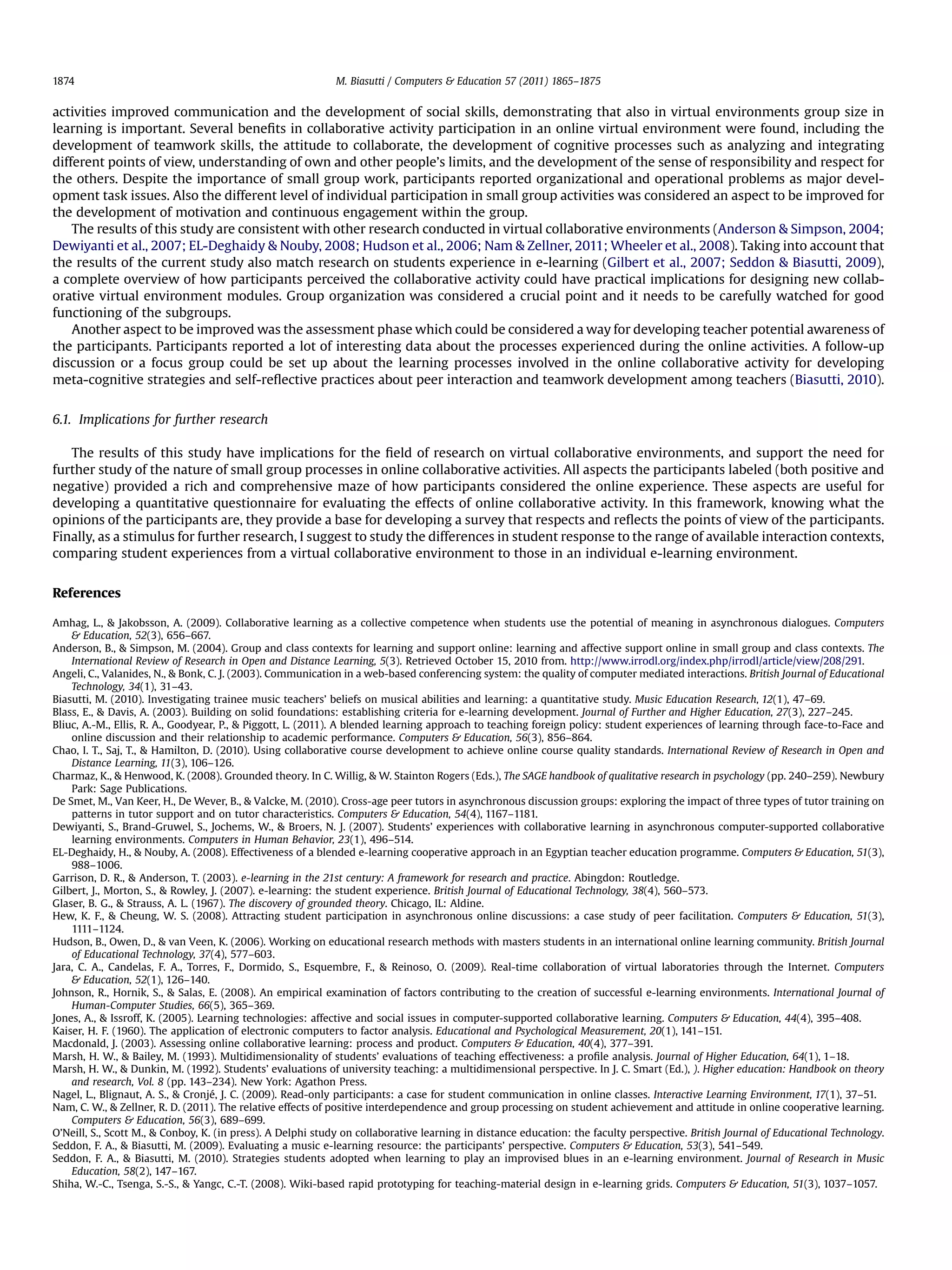This paper evaluates student experiences in a collaborative e-learning module designed for primary school teacher education. Data was collected through a self-evaluation questionnaire to assess satisfaction and identify strengths and areas for improvement, revealing themes around teamwork, cognitive engagement, and organizational aspects. The findings suggest that while the module promoted collaborative skills and peer learning, enhancements are needed in coordination, workload management, and addressing technical issues.
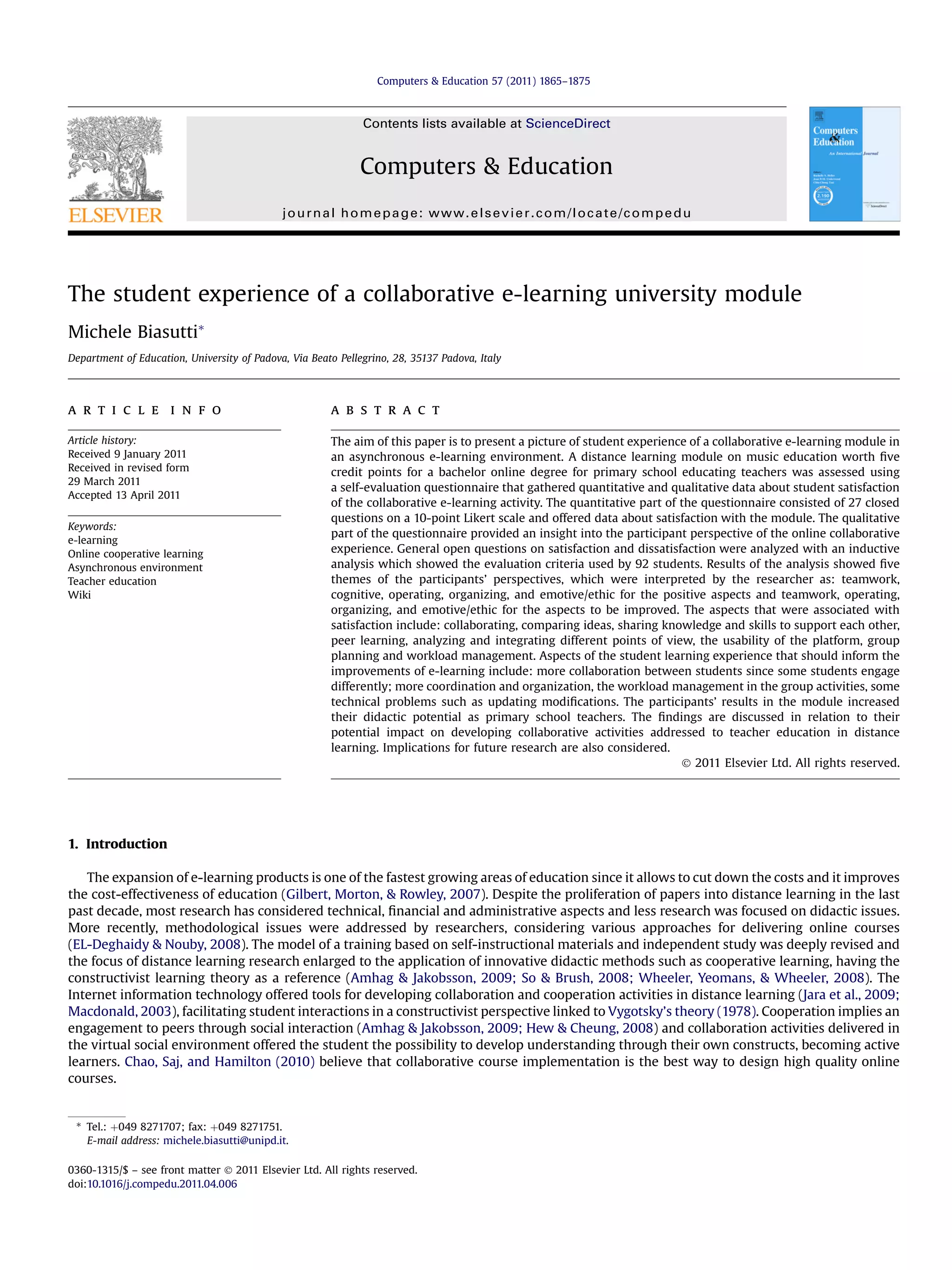
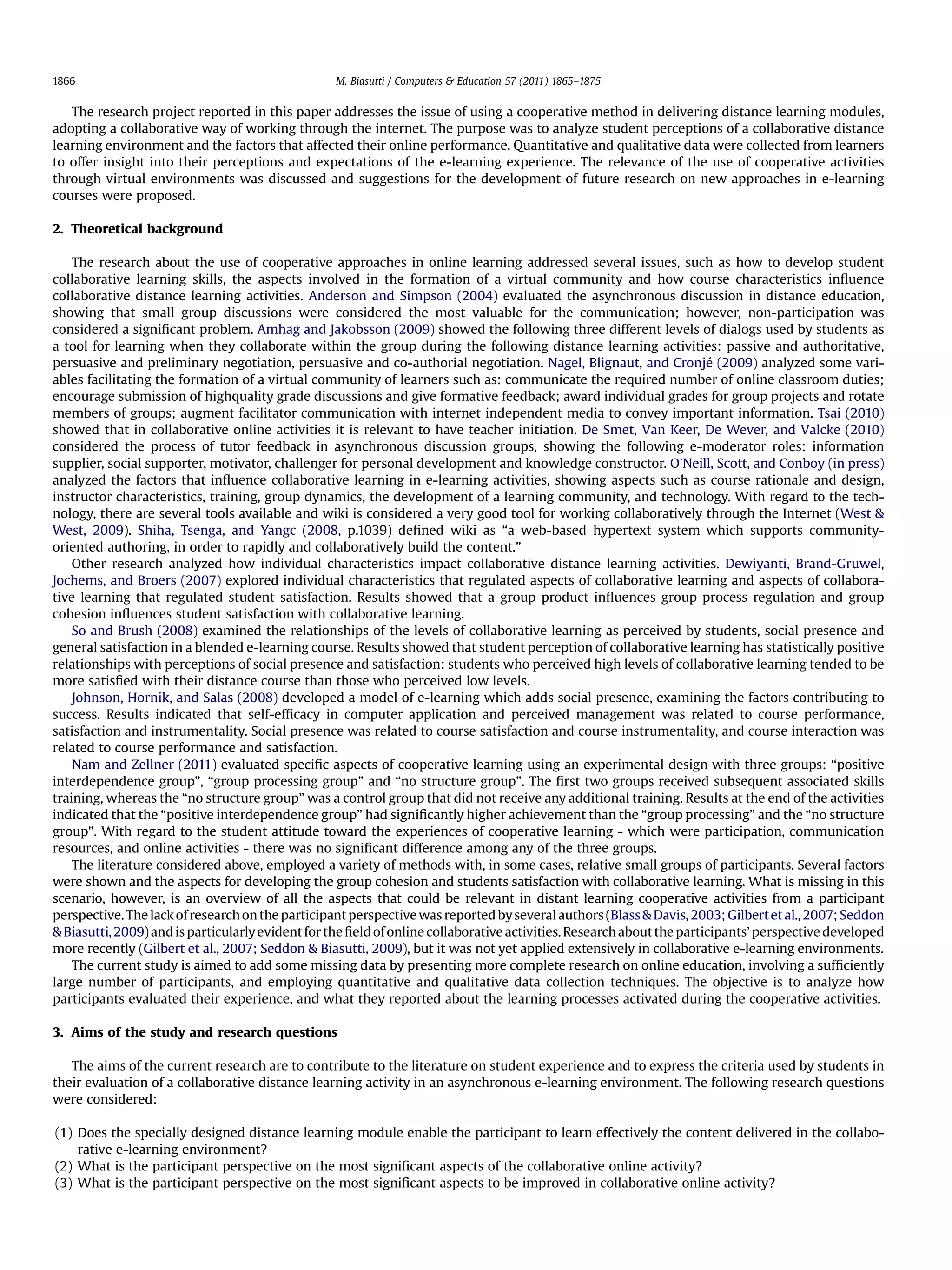
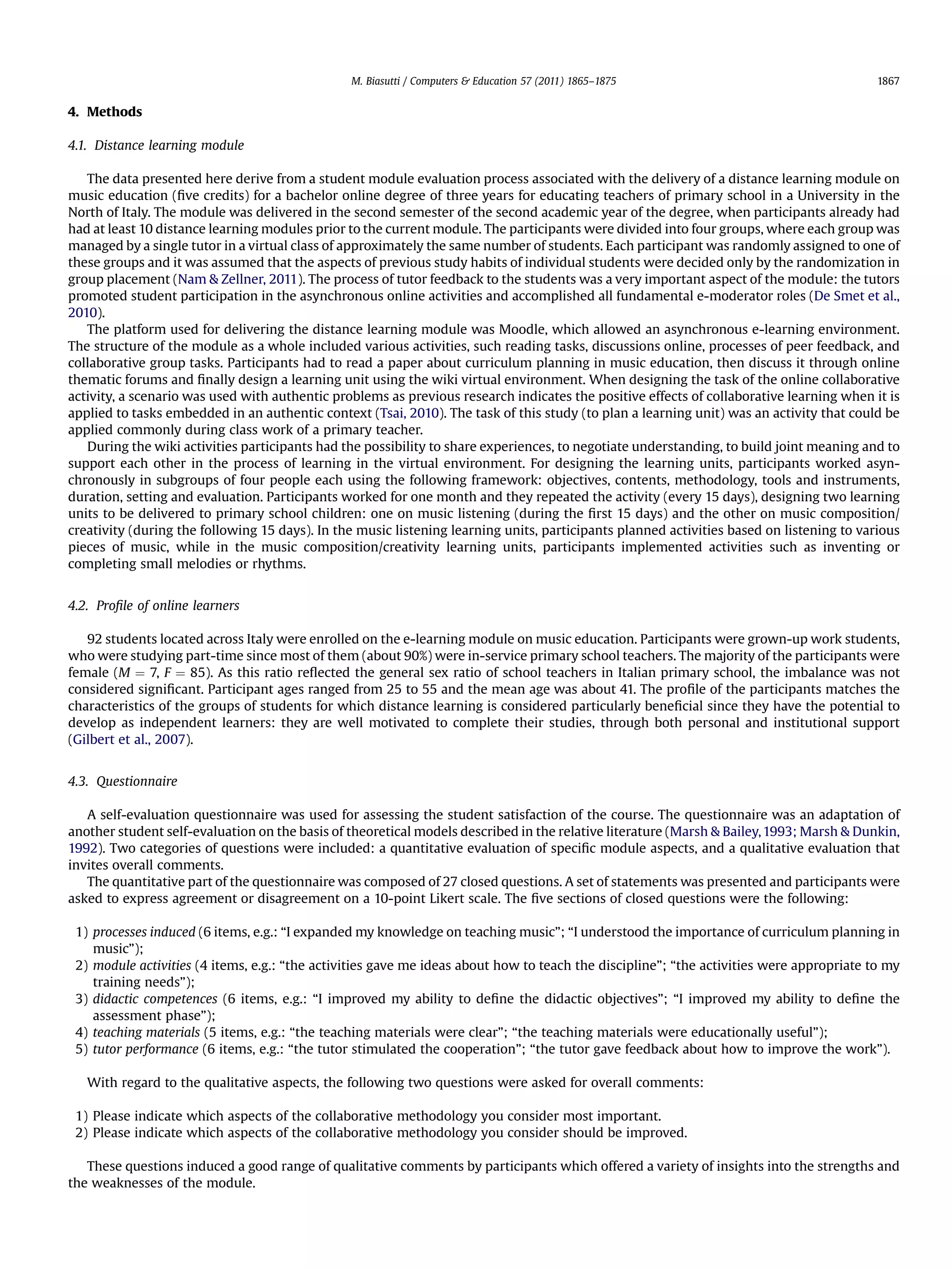
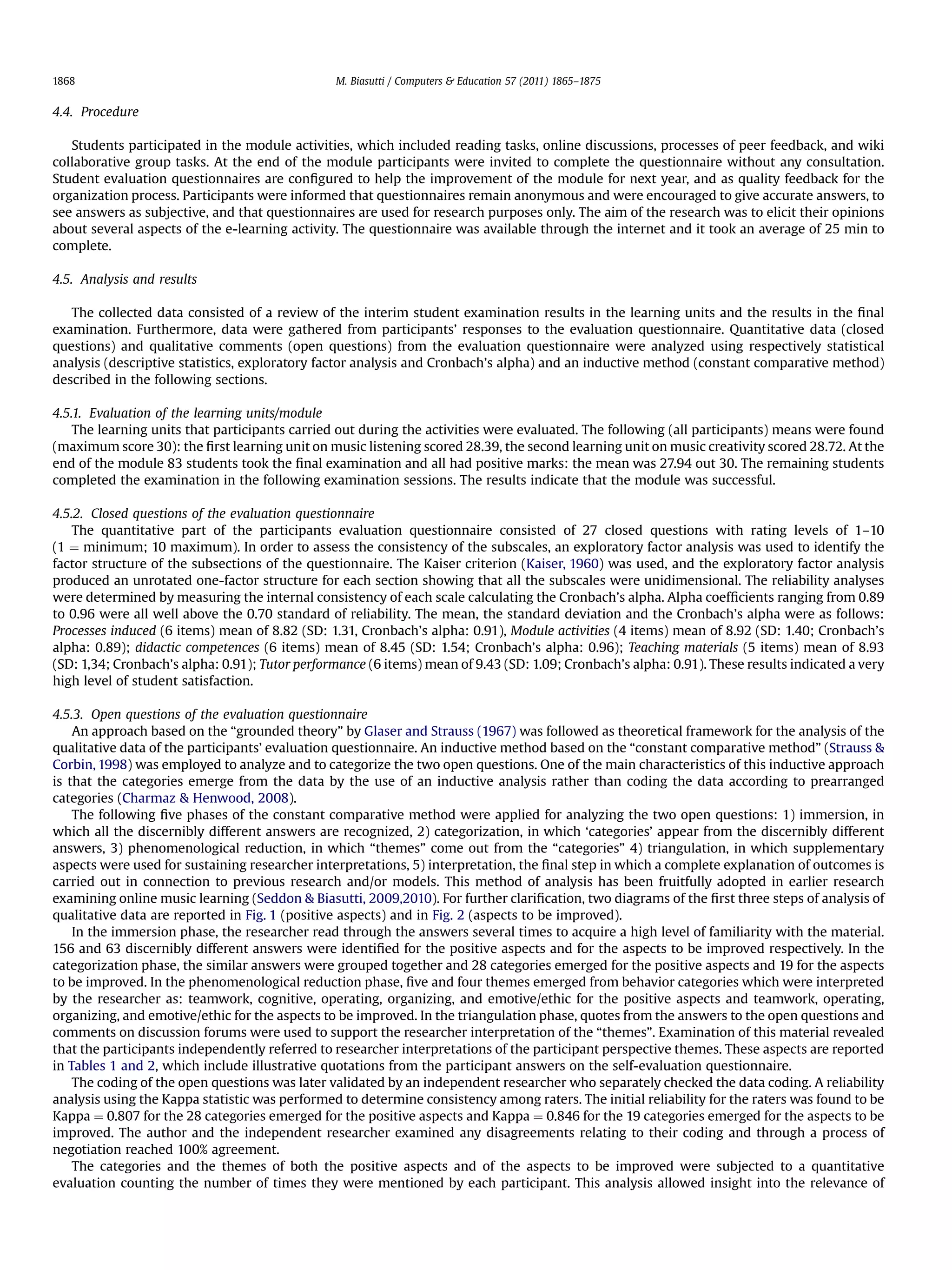
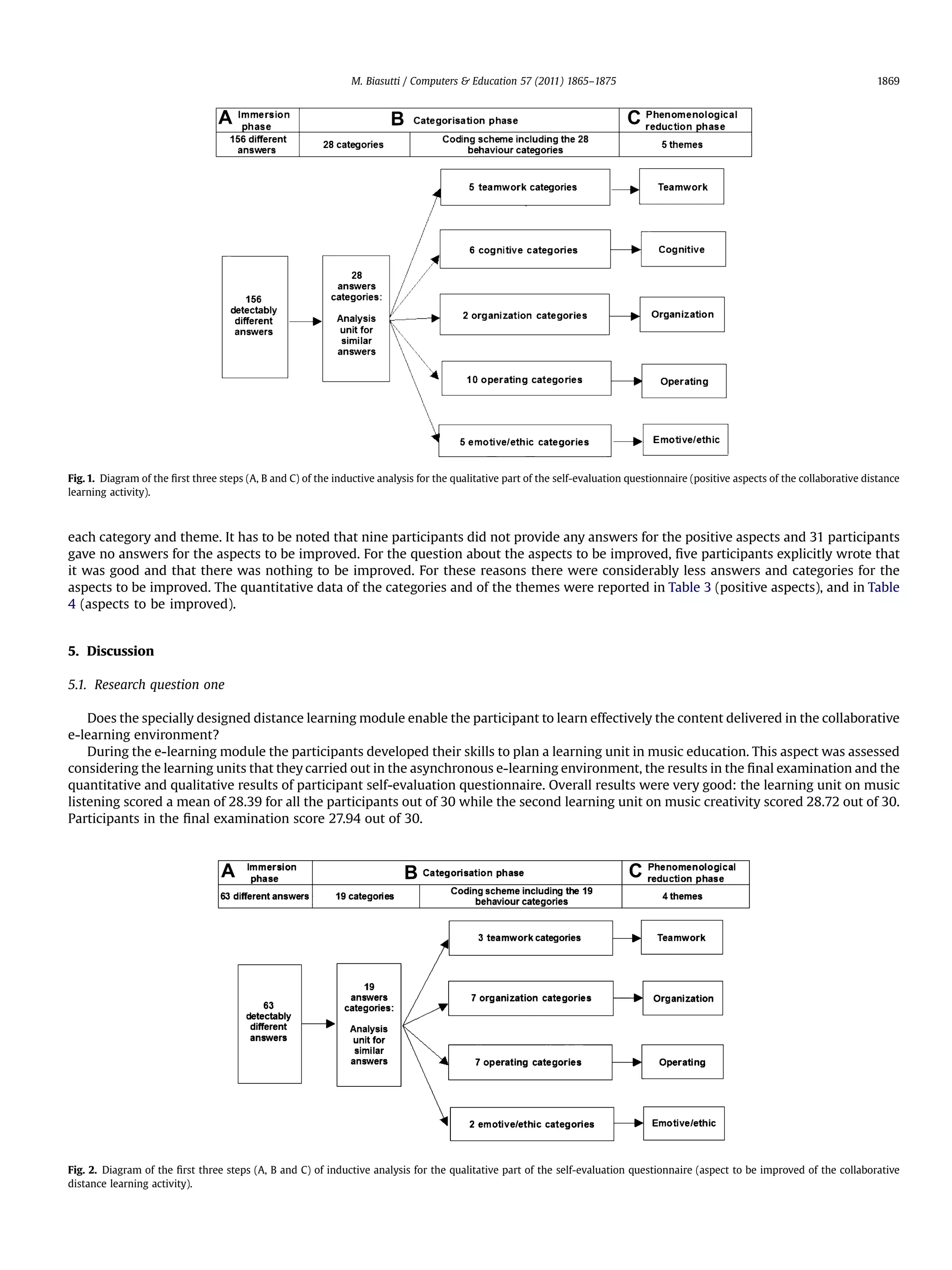
![Table 1
Triangulation phase: supporting quotes for the five themes of the positive aspects of collaborative distance learning activity extracted from the answers given by participants.
Themes Supporting quotes Interpretation
Teamwork “It was nice because I was involved in
collaborating with other colleagues for learning
during the activities.”
These quotes support explanations of
‘teamwork’ theme in which the participants
express social components of the learning
process.“We realized a product that is really the
expression of a teamwork.”
“We worked collaboratively with many hands on
the same document.”
“We shared different experiences and opinions.”
Cognitive “I learned from the others who knew more than
me.”
These quotes support explanations of ‘cognitive’
theme in which the participants express mental
components of the learning process.“We analyzed and integrated different points of
view.”
“I learned to cooperate and to collaborate.”
“I understood my own and other people’s limits.”
Organization “We organized a rich and complete learning unit.” These quotes support explanations of
‘organization’ theme in which the participants
express the management components of the
learning process.
“It was helpful for organizing the activity.”
“It was useful for scheduling the time rationally.”
“We distributed the workload in an organized
way.”
Operating “Wiki is the ideal tool to produce a collective
document.”
These quotes support explanations of ‘operating’
theme in which the participants express the
advantages of the interventions.“It was useful because it allowed us to contribute
when the work had already begun, to make
updates, to insert personal points of view and
these modifications were not definitive and any
update was possible.”
“It was very interesting to see how the work grew
and was shaped.”
“It is a simple tool.”
Emotive/ethic “The friendly environment and teamwork were
very supportive and this facilitated the process.”
These quotes sustain explanations of the
‘emotive/ethic’ theme in which the participants
report their feelings and the ethic.“I felt a positive environment.”
“I developed my sense of responsibility.”
“We worked in a dimension of respect for all participants.”
Table 2
Triangulation phase: supporting quotes for the four themes of the negative aspects of collaborative distance learning activity extracted from the answers given by participants.
Themes Supporting quotes Interpretation
Teamwork “I think it is needful to have a preliminary
discussion and agreement.”
These quotes support explanations of the ‘teamwork’
theme in which the participants express social
components of the learning process.“The wiki activity is very positive if there is
cohesion and cooperation within the group.”
“It is essential to have the effective
participation of all the participants.”
“The main problem was the different level of
participation within the group.”
Organization “It is important to have more coordination
and organization in the work”.
These quotes support explanations of the ‘organization’
theme in which the participants express the
management components of the learning process.“The sectoral organization of the work does
not allow easy checking of the whole
document.”
“Greater division of the work.”
“Timing: it was difficult to coordinate times
with the commitments of each participant.”
Operating “I had problems in updating modifications.” These quotes support explanations of the ‘operating’
theme in which the participants express the problems
in the interventions.
“The software was too sophisticated.”
“It would be nice to use all the functions of
wiki such as references, links [.].”
“It would be interesting, but I do not know if
it is technically possible, to support the wiki
methodology with a synchronous
communication tool, such as chat.”
Emotive/ethic “Greater confidence in the wiki tool and in
the possibilities that it offers.”
These quotes sustain explanations of the ‘emotive/ethic’
theme in which the participants report their feelings
and the ethic.“Scarse respect for the others.”
“Stricter ethics.”
“Scanty of mutual respect.”
M. Biasutti / Computers & Education 57 (2011) 1865–18751870](https://image.slidesharecdn.com/1-s2-200925055312/75/The-student-experience-of-a-collaborative-e-learning-university-module-Michele-Biasutti-6-2048.jpg)
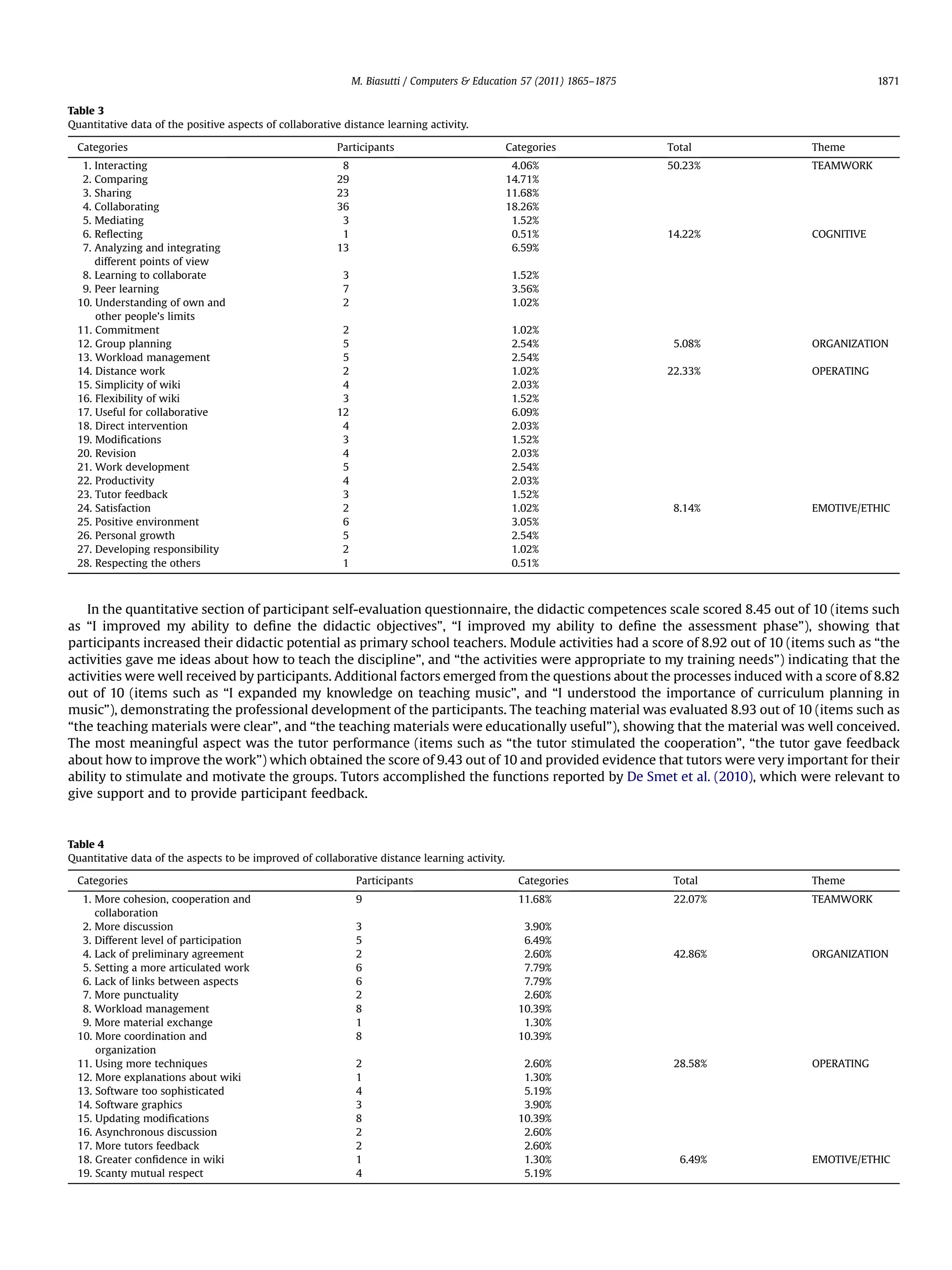
![Also, in the qualitative part of the evaluation (open questions), participants expressed specific comments about the most successful
aspects of the module as well as a general satisfaction about the activities delivered. Comments such as “It was a very good tool for
developing teamwork and producing a specific document”; and “it was a positive experience. My group was very collaborative and this
allowed us to create valid leaning units because there was comparison between us and coherence in the work.”, were reported by
participants.
It could be argued that one possible reason for the effectiveness of the module was because it applied the following main components:
correct pedagogical approach, proper technology, clear and organized didactic material, opportunity for participants collaboration, group
dynamics, support and online tutor feedback (Blass & Davis, 2003; Garrison & Anderson, 2003; O’Neill et al., in press). In the current study,
also the virtual environment was relevant since it presented a simple yet efficient asynchronous e-learning setting, which allowed
participants to work collaboratively through the internet, to share experiences, to build joint meaning and to support each other in the
process of learning with the help of the online tutor. This interpretation of the results supports the findings of analog research on
collaborative online learning conducted by Nam and Zellner (2011).
5.2. Research question two
What is the participant perspective on the most significant aspects of the collaborative online activity?
Responses to the general question on the aspects of the module activity that were useful, showed the criteria expressed by participants.
Results of the inductive analysis revealed the following five themes: teamwork, cognitive, operating, organizing, and emotive/ethic. The
participant perspective assigned a great value of the teamwork theme as the most relevant aspect of the online collaborative activity. The
development of social skills during teamwork was considered very important by participants as it is shown in the following example: “[.]
Wiki is a gym where young and old can work out their social skills, just like our children at school, to whom every day we try to teach
collaboration, cooperation, and to see the diversity of the individuals as a resource. And where understanding each other can be a bit
difficult, it is certainly a significant opportunity to grow together.” This outcome supports the research findings by Jones and Issroff (2005),
who provided evidence of affective and social issues in computer-supported collaborative learning. Gilbert et al. (2007) reported that
discussion forums and other student interactions were mentioned by participants as one of the most important aspects of the e-learning
activity, So and Brush (2008) considered the student perception of collaborative learning as an indicator of satisfaction of the e-learning
course and Johnson et al. (2008) showed that course interaction was related to course performance and satisfaction.
In the current research, online collaboration was useful for the learning process and aspects such as “it was nice because I was involved in
collaborating with other colleagues for learning during the activities”, and “it was important for the continuous inter-exchange of ideas
between people sharing the same aims” were reported by the participants. The importance of being member of a group as a factor for their
collaboration was perceived by a number of participants: “we realized a product that is really the expression of a teamwork”, and “we
worked collaboratively with many hands on the same document”. Group members collaborated and established a group cohesion during
the realization of the task: “we shared knowledge and skills to support each other”, showing mutual support among group members.
These findings are coherent with Anderson and Simpson (2004, p.2) who reported: “when students are remote, online communication
provides an effective means of drawing students together to develop a sense of community”. Hudson, Owen, and van Veen (2006) suggested
that the students’ feeling of the atmosphere of the learning community promoted their learning. In line with the Hudson et al. (2006) the
relevance of social aspects could be argued and that the feeling of being part of a learning community is an important characteristic linked to
the studying process.
Other aspects considered were the operational ones, with about 22% of the answers. The comments reported by participants were
connected with the platform which was considered particularly useful for the online collaboration and to produce a collective document.
“Wiki is a valuable resource: I like to call it building work in progress. In the various sections you have the opportunity to review the routes,
to modify them layer after layer, always enjoying the safety of software that keeps track of any changes [.] This is valuable! It is an
environment - community of practices, where you can co-construct - polishing, removing, adding, expanding, improving - to get valid and
acceptable results, especially in terms of product quality and process.”
Also other practical aspects were mentioned, including the flexibility of wiki as a facilitator for the development of collaborative online
tasks: “It was useful because it allowed us to contribute when the work had already begun, to make updates, to insert personal points of
view and these modifications were not definitive and any update was possible.”. This finding supports the study by Wheeler et al. (2008)
who analyzed the advantages in the use of wiki. Another interesting aspect linked to the way of working was the perception of the
development of the work and seeing how the work grew and was shaped: “It was interesting to observe how from the first ideas, gradually,
thanks to the clarifications, the workable units have been defined. It was most rewarding to let the exchange of different experiences define
the activities to be carried out in practice”, was mentioned by one participant.
The collaborative online activity developed also the feeling that the cognitive domain was important (about 14% of the answers).
Participants mentioned processes linked to the social dimension of cognitive development, such as “I learned to cooperate and to collab-
orate”, and “I learned from the others who knew more than me” that showed the importance of peer learning in agreement with
EL-Deghaidy and Nouby (2008) who reported learning from peers as a relevant aspect of a collaborative e-learning activity. The quality of
the cognitive processes could be discussed also, as they occurred during the activity. Several studies addressed that in online discussion
forums there are extensive interactions in which processes such as giving of information and exploration of ideas were included, but more
complex elaborations such as integration of ideas and synthesis of a range of perspectives were substantially less considered (Anderson &
Simpson, 2004; Angeli, Valanides, & Bonk, 2003). In the current research, it seems that also upper levels of cognitive skills were involved
since participants reported aspects such as: “we analyzed and integrated different points of view”, which showed that the wiki virtual
environment enables students to collaboratively synthesize subject specific knowledge, developing also critical thinking skills. These
findings are coherent with Bliuc, Ellis, Goodyear, and Piggott (2011) who showed deeper focus on specific aspects of the topics during
asynchronous discussions.
It could be argued that also other characteristics than the wiki tool were relevant, such as course planning, since previous research
showed that the instructional design could influence the way in which participant interact (Anderson & Simpson, 2004). In the current
M. Biasutti / Computers & Education 57 (2011) 1865–18751872](https://image.slidesharecdn.com/1-s2-200925055312/75/The-student-experience-of-a-collaborative-e-learning-university-module-Michele-Biasutti-8-2048.jpg)
![research, the task of curriculum planning was conceived for addressing abilities such as integrating different modalities and facilitating the
synthesis of concepts since the final result was not only a mere discussion, but a definite product (the learning unit) was realized. Also the
small size of the group intensified the possibilities for engagement reaching to greater opportunities for the integration of different points of
view: “it was very surprising to develop such a variety of interesting learnings within the group”, one participant said. The online tutor had
a fundamental role in this, facilitating the activated processes and guiding the activities toward higher-order cognitive levels (Anderson &
Simpson, 2004).
The emotive/ethic theme had about 8% of the answers reporting the participants’ satisfaction since they felt a positive environment and
reported a personal growth: “the friendly environment and teamwork were very supportive and this facilitated the process”. Also the
following ethic aspects were reported: “I developed my sense of responsibility” and “we worked in a dimension of respect for all partici-
pants”. This result supports the findings of other studies, in which the relevance of emotive aspects in computer-supported collaborative
learning was shown (Jones & Issroff, 2005). These findings provided evidence that the virtual environment, as well as the face-to-face
environment, involved social and emotive aspects at the same time.
Finally, 5% of the answers were about organization, expressing the management aspects of teamwork such as the articulation of group
planning and workload: “it was helpful for organizing the activity”; “it was useful for scheduling the time rationally” were some comments
reported by participants. There was also a reference to the coordination of the subgroup activities: “we distributed the workload in an
organized way”. This theme was not often mentioned by participants since it received only the 5% of the total answers, probably because it
was the most crucial activity factor to be improved, as we discuss below.
5.3. Research question three
What is the participant perspective on the most significant aspects to be improved in collaborative online activity?
It could be argued that online collaboration has some weak points, even within the picture of success provided by the questionnaire
results and comments reported above. Responses to the general question on the aspects of the module that would be improved in the future,
showed some interesting suggestions expressed by participants. They reveal the following four themes: teamwork, operating, organizing,
emotive/ethic. The participant perspective showed a great value of the organization theme (42% of the answers) as the most relevant aspect
to be improved of the online module. Aspects such as more coordination and organization, workload management, lack of links between
aspects, greater division of the work, and more relaxed time of work were addressed for improving the organization of the module. One
participant said: “for me the organization represents the core business of the wiki approach: the division of tasks (often interlaced) and the
ability of the group to allow the construction of a project that is impossible to do individually. You must be willing to write, edit, and lose
your own ideas.” The importance was mentioned of clearly defining the assignments within the group: “the only thing to do, maybe, is to
better define the tasks that each member has to do”. One participant addressed the importance of having a coordinator within the group: “to
recognize immediately a persons as work coordinator, which in other courses are called “secretary”, would have facilitated finding the right
way: it’s not easy among many thinking heads and so many ideas, just how to find the right way and the right method to be followed from
the beginning. This is also because it is a work of mediation, cooperation and ongoing revision, and would require a little more time.” Other
participants expressed different opinions: “small group size was valuable, as well as peer collaboration without having a coordinator run the
group.” and “I don’t think it’s right to have a group coordinator, because it is not right that one person has to do more work than the others”.
Other comments provided evidence of specific work organization aspects to be improved: “it is important to find ways to better coordinate
the various parts of the text”; and “the sectoral organization of the work does not allow easy checking of the whole document”. Other
research reported organizational problems and ambivalence regarding the potential of the wiki (Wheeler et al., 2008).
Also, the operating theme was relevant (28% of the answers) and aspects such as “updating modifications”; “too sophisticated software”;
were addressed. One participant suggested to use more techniques: “It would be interesting, but I do not know if it is technically possible, to
support the wiki methodology with a synchronous communication tool, such as chat.”. These findings support research by Wheeler et al.
(2008), who reported some problems in using the software during the collaborative e-learning activities.
The teamwork theme represented about 22% of the answers of the participants, addressing mainly more cohesion, collaboration and
discussion within the group. The issue of the group constitution and cohesion was mentioned by a participant: “in itself, to work online with
wiki is not complex and it’s so exciting, but it involves a feeling among the members of the group which is not so simple to build. Initially,
you spend time “to get to know each other” and to break the ice, as we say. Then, during the fully blown activity, it can happen that proposals
are made which are not understood by some of the members (it happened also to me). Sometimes I was afraid to intervene in the work of
others in a too invasive way [.]”. This statement demonstrated that collaborative online learning works if you are able to create the group.
These findings are coherent with Dewiyanti et al. (2007) who showed that group cohesion influences student satisfaction with collaborative
learning. Other comments were: “the main problem was a different level of participation” demonstrating that the small group nature of
much of the work is dependent on all students participation (Anderson & Simpson, 2004; Gilbert et al., 2007). If one or two participants in
a group of four or five decide to not participate, or participated with low commitment, this behavior cuts down the number of potential
linkages significantly, reducing the quality of the induced processes. There is a difference between the current research and the previous
research (Anderson & Simpson, 2004), where non-participation in online group activities was the major concern expressed by participants,
whereas in the current research it was the third according to percentage. These results could explained by the different characteristics of the
participants and the organization of the two studies.
The last theme was the emotive/ethic (about 6% of the answers) and comments such as “Greater confidence in the wiki tool and in the
possibilities that it offers”; “stricter ethics” and “scanty of mutual respect” were expressed. These findings confirm the already mentioned
relevance of emotive aspects in virtual collaborative learning environments (Johnson et al., 2008; Jones & Issroff, 2005; So & Brush, 2008).
6. Conclusion
The current research provided the participants perspective of an e-learning module, proposing collaborative activities in an asyn-
chronous e-learning environment and informed us about the processes that occurred during the module. For nearly all students, small group
M. Biasutti / Computers & Education 57 (2011) 1865–1875 1873](https://image.slidesharecdn.com/1-s2-200925055312/75/The-student-experience-of-a-collaborative-e-learning-university-module-Michele-Biasutti-9-2048.jpg)
